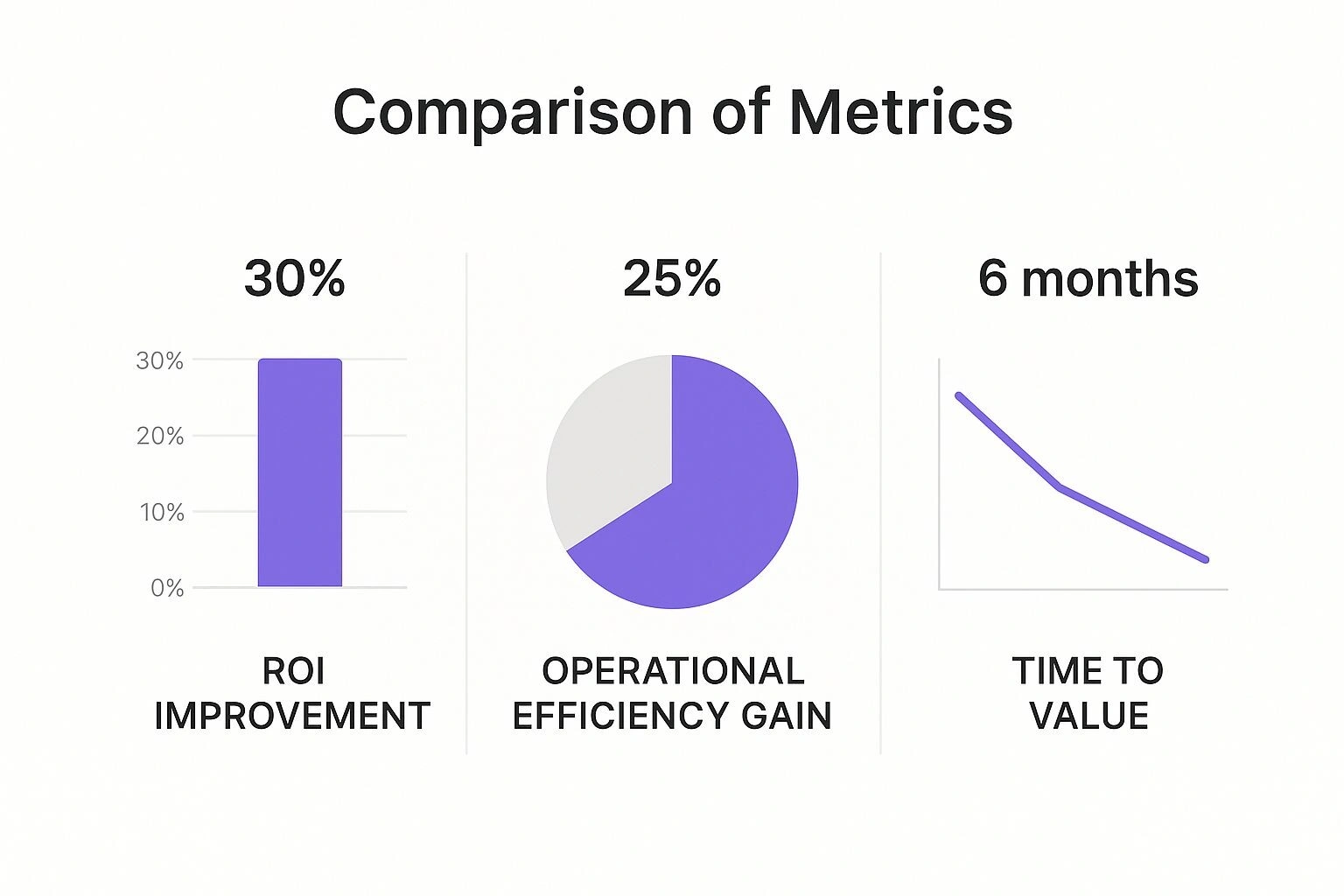Digital Transformation Strategy Tips for Success
Learn essential digital transformation strategy tips to drive successful change. Discover proven approaches to boost your digital initiatives today.

Building Your Digital Transformation Strategy Framework
A successful digital transformation strategy isn’t solely about adopting new technologies. It’s about establishing a framework that aligns people, processes, and technology with your overall business objectives. This requires a structured approach, starting with a digital maturity assessment.Like a health check before a new fitness regime, this assessment helps organizations understand their current digital capabilities and pinpoint areas for improvement.It’s the foundation upon which a targeted strategy is built.
Defining Your Vision and Objectives
After understanding your current position, the next crucial step is defining a clear vision for what you hope to achieve through digital transformation.What are your goals? Are you striving to improve customer experience, streamline operations, or perhaps expand into new markets?A retailer, for example, might envision a seamless omnichannel experience, while a manufacturer might prioritize automating production processes.It’s important that these objectives are SMART: Specific, Measurable, Achievable, Relevant, and Time-bound.This clarity provides a crucial roadmap and helps measure your progress.
Key Components of a Robust Framework
A robust digital transformation framework comprises several interconnected components:
-
Stakeholder Alignment: Securing buy-in from everyone, from the C-suite to frontline employees, is critical. This requires clear communication about the vision, benefits, and potential impacts of the transformation.Addressing concerns and providing adequate training minimizes resistance and promotes a sense of shared ownership.
-
Governance Structure: A defined governance structure ensures accountability and streamlines decision-making.This typically involves establishing a steering committee, defining roles and responsibilities, and implementing reporting mechanisms.This structure keeps the transformation focused and within budget.
-
Technology Roadmap: Selecting the right technologies is paramount. Equally important is having a roadmap for their implementation. This roadmap should outline the sequence of technology deployments, integration plans, and resource allocation.It’s the detailed itinerary for your transformation journey.
-
Change Management Plan: Digital transformations frequently necessitate significant changes to existing workflows and processes. A thorough change management plan helps navigate these changes smoothly, minimizing disruptions and ensuring a seamless transition.Providing sufficient training and support to staff is vital for successfully adopting new systems.
To help illustrate the different strategic approaches across various organizational sizes and complexities, consider the following table:
To understand how different organizations approach digital transformation based on their size and structure, let’s look at the following comparison:
Digital Transformation Strategy Components Comparison
A comprehensive comparison of essential strategy components across different organisational contexts and maturity levels.
| Strategy Component | Small Business | Mid-Market | Enterprise | Government |
|---|---|---|---|---|
| Digital Maturity Assessment | Focused on immediate needs and quick wins | Broader assessment linking to departmental goals | Comprehensive, enterprise-wide assessment | Complex, multi-agency assessments with citizen impact focus |
| Vision & Objectives | Agile, adaptable vision aligned with market changes | Scalable vision supporting growth plans | Long-term vision incorporating market disruption | Public value driven, citizen-centric vision |
| Stakeholder Alignment | Direct engagement and communication | Structured communication and training programs | Multi-channel communication strategies | Public consultations and stakeholder engagement programs |
| Governance Structure | Lean, flexible governance | Formalized governance with clear reporting | Robust governance framework with oversight committees | Multi-layered governance with public accountability |
| Technology Roadmap | Phased implementation focused on integration | Scalable roadmap supporting modular deployments | Integrated roadmap aligning with enterprise architecture | Long-term roadmap incorporating legacy systems and interoperability |
| Change Management | Hands-on support and training | Structured change management programs | Dedicated change management teams | Phased change rollout with citizen engagement and support |
This table highlights the increasing complexity and formality of digital transformation strategies as organizations grow and their missions evolve. While small businesses prioritize agility and quick wins, larger enterprises and government entities require more comprehensive, long-term approaches.
Measuring Success and Driving Continuous Improvement
Continuous improvement is essential for lasting success.Strategies to improve marketing efficiency are particularly valuable.Closely monitoring key metrics such as ROI improvement, operational efficiency gain, and time to value provides quantifiable data points for your progress.The infographic below visually represents the potential positive effects of a well-executed digital transformation strategy:

This data shows the possibility of significant returns, including a 30% ROI improvement, a 25% operational efficiency gain, and a time to value of 6 months. These metrics provide concrete evidence of the transformation’s positive impact and justify further investment.Australia’s digital transformation strategy, involving 110 major digital projects as of 2025, exemplifies this commitment to enhancing public services and government efficiency.You can explore more about Australia’s digital transformation initiatives. By embracing a structured approach and focusing on continuous improvement, organizations can effectively manage the complexities of digital transformation and achieve their intended goals.
Understanding Australia’s Digital Transformation Landscape
The Australian digital transformation environment offers a unique blend of opportunities and challenges. It’s a vibrant ecosystem where organizations are using digital technologies to stay ahead of the competition, improve customer experiences, and streamline operations.This goes beyond simply adopting the latest technology; it requires a deep understanding of the Australian market and a tailored digital transformation strategy.
Sector-Specific Transformation Patterns in Australia
Distinct transformation patterns are emerging across various sectors.In the retail sector, the emphasis is on providing seamless omnichannel experiences that blend online and offline interactions.Financial institutions are increasingly adopting FinTech solutions to simplify processes and personalize customer interactions.The manufacturing industry is exploring advanced automation and Industry 4.0 technologies to boost efficiency and productivity.
The rise of “buy now, pay later” services, for example, demonstrates a significant shift in consumer behaviour and has prompted rapid adaptation among Australian retailers.This highlights how specific market trends can fuel transformation within a particular sector.Government initiatives like the Consumer Data Right are also reshaping how businesses collect and use data, further influencing the digital transformation landscape.
The Role of Government Initiatives
Government initiatives play a vital role in shaping Australia’s digital economy. These initiatives not only drive investment in digital infrastructure but also encourage innovation and the adoption of new technologies.This significantly impacts the overall digital transformation strategy for businesses operating in Australia.
Businesses must now adapt to new regulations and standards, which present both challenges and opportunities.This active role by the government creates a supportive environment for digital transformation, providing businesses with the incentives and resources they need to implement effective strategies.This collaborative approach between the public and private sectors contributes to the overall growth and competitiveness of the Australian economy.
Positioning for Competitive Advantage
Australia’s digital transformation market is experiencing rapid growth, with a projected compound annual growth rate (CAGR) of 31.8% from 2025 to 2030.Fueled by increasing demand for digital solutions, this growth underscores the significant expansion of Australia’s digital economy, currently valued at A$167 billion, an 80% increase in the last five years.Find more detailed statistics here.To succeed in this dynamic environment, businesses must develop robust digital transformation strategies.
This means more than just implementing new technologies. Organizations need to cultivate a digital-first culture, invest in their workforce’s digital skills, and develop agile and adaptable business models.Leveraging data analytics to gain deeper insights into customer behaviour and market trends is also essential.By taking these steps, businesses can effectively position themselves for competitive advantage and thrive in the evolving Australian digital landscape.

Smart Technology Investment and Budget Planning Strategies
A successful digital transformation strategy requires more than just adopting new technologies.It demands a smart approach to investment and budget planning. Simply spending money on the latest trends won’t guarantee success.Instead, businesses should focus on aligning technology investments with their overall business objectives. This involves carefully analyzing where leading Australian companies are allocating their budgets and understanding how those investments translate into tangible returns.
Prioritizing Investments for Maximum Impact
Australian organizations are increasingly prioritizing investments in key areas like cloud computing, cybersecurity, and emerging technologies such as AI and automation. Cloud computing, offered by providers like Amazon Web Services (AWS), provides the flexible infrastructure necessary for scaling operations and supporting remote work.Cybersecurity is paramount given the increasing threat of data breaches and the importance of protecting sensitive information.AI and automation offer opportunities to streamline processes, improve efficiency, and gain a competitive edge.
For example, a company might invest in AI-powered chatbots to enhance customer service and free up human agents for more complex tasks.This targeted approach ensures that technology investments directly address business needs and contribute to overall goals. It’s not about having the newest technology, but about using technology strategically to solve specific challenges and drive measurable improvements.
To understand how different sized businesses in Australia are prioritizing their tech investments, let’s take a look at the following table.It provides a breakdown of investment areas and their expected ROI timelines.
Technology Investment Priorities by Business Size
| Technology Area | Small Business % | Medium Business % | Large Enterprise % | ROI Timeline |
|---|---|---|---|---|
| Cloud Computing | 45% | 55% | 65% | 12-18 Months |
| Cybersecurity | 30% | 40% | 50% | 6-12 Months |
| AI & Automation | 15% | 25% | 35% | 18-24 Months |
| Data Analytics | 10% | 15% | 20% | 12-18 Months |
As the table highlights, larger enterprises tend to invest more heavily in AI and Automation, while smaller businesses focus on the more immediate benefits of cloud computing and cybersecurity.Regardless of size, all businesses recognize the importance of these key technology areas.
Budget Planning Frameworks for Digital Transformation
Effective budget planning is essential for a successful digital transformation.This involves establishing clear links between transformation objectives and budget allocation.A digital transformation budget should outline projected costs for each phase of the project, including software, hardware, training, and ongoing maintenance.
IT spending in Australia is projected to reach AU$147 billion in 2025, an 8.7% increase from the previous year. Software investments, particularly in cybersecurity, generative AI (GenAI), and cloud computing, are expected to drive much of this growth, increasing by 13.4%.This growth is largely due to concerns around data breaches and the rising importance of GenAI in data centers. Learn more about IT spending trends in Australia.This data reinforces the need for strategic budget allocation aligned with current market trends and critical business needs.
Vendor Selection and Technology Roadmaps
Choosing the right technology vendors is crucial for avoiding costly mistakes and ensuring seamless integration. This means developing clear vendor selection criteria based on factors such as experience, reputation, and support services. A detailed technology roadmap is equally important.This roadmap should outline the planned sequence of technology deployments and how these deployments will contribute to the overall transformation journey.

By carefully considering these aspects, organizations can maximize the return on their technology investments and ensure that their digital transformation strategy delivers consistent value and positions them for future success. This proactive approach to investment and budget planning is crucial for achieving long-term business objectives.
Leading Organisational Change And Cultural Transformation

The biggest hurdles companies face during digital transformation are often not technological, but human. A successful digital transformation strategy requires a shift in organizational culture and a willingness to embrace change. This means addressing potential resistance, fostering a culture of continuous learning, and adapting strategies as the transformation progresses. This is vital for businesses that want to remain competitive.
Building Digital Readiness
Building digital readiness across teams requires a multifaceted approach. First, clear communication about the reasons behind the transformation is essential. This involves explaining the benefits, addressing employee concerns, and providing adequate training. For example, highlighting how new systems can simplify tasks and boost efficiency can resonate with employees more effectively than just focusing on technical upgrades.
Secondly, fostering a culture of psychological safety, where employees feel comfortable experimenting and learning new skills, is critical. This reduces fear of failure and encourages active participation in the transformation.
Creating a Culture of Innovation
Digital transformation thrives in a culture that truly supports innovation.This means empowering employees to experiment, take risks, and challenge existing processes. Recognizing and rewarding innovative thinking reinforces this culture and encourages more experimentation.
This might involve establishing internal innovation programs or dedicating time for employees to explore new ideas.This fosters a proactive approach to problem-solving and generates new ideas for utilizing digital technologies.This is akin to the growth mindset championed at Microsoft, where employees are encouraged to be lifelong learners.
Maintaining Transformation Momentum
Maintaining momentum throughout a digital transformation can be difficult, especially as initial enthusiasm fades. Regular communication, celebrating small wins, and providing ongoing support are essential.Additionally, establishing clear metrics and tracking progress against them demonstrates the transformation’s benefits and keeps teams engaged.This creates a sense of accomplishment and reinforces the value of the journey. Read also: How to master AI Adoption in the Enterprise.
Furthermore, adapting people strategies as the transformation progresses – such as adjusting roles and responsibilities or providing extra training – ensures the workforce is prepared for the evolving demands of the digital environment.This proactive approach to people management and culture is crucial for long-term success.Just as Microsoft learned to manage shadow IT through trust and updated policies, organizations need to establish clear governance structures and empower employees to explore new technologies within a secure and managed environment. By addressing the human element of digital transformation, organizations can effectively navigate change, cultivate a culture of innovation, and achieve their strategic objectives.
Creating Implementation Roadmaps That Actually Work
Big digital transformation plans often fail without a clear roadmap. This section explores how successful Australian organizations turn their digital strategies into real progress. We’ll move past the theory and examine the practical steps of making strategy a reality.
Breaking Down Complex Initiatives
Large transformation projects can feel overwhelming.The key is breaking them down into smaller, manageable steps. This phased approach makes the project less daunting and allows for adjustments along the way.It’s like building a house – you start with the foundation and build up from there.
This approach also builds stakeholder confidence by showing progress and delivering early wins. These early successes create momentum and secure buy-in for future phases.
Establishing Clear Milestones and Success Criteria
Each phase needs clearly defined milestones and success criteria. Milestones are checkpoints to track progress and stay on course.Success criteria define what “done” looks like for each phase.
For example, if a phase involves migrating data to the cloud, a milestone could be completing the migration by a certain date.A success criterion could be achieving 99% data integrity after the move. This clarity ensures everyone is working towards the same goals.You might be interested in: How to create an Automation Roadmap for your Organisation.
Project Management for Transformation Complexity
Effective project management is essential for navigating complex transformations.Traditional methods may not be enough. Organizations should consider agile approaches that allow for flexibility and adaptation. Think of it like a road trip – you have a planned route, but you must be prepared for detours.
This adaptability is crucial for digital transformations, where unexpected challenges and changing business conditions are common.
Adaptive Strategies and Risk Management
A successful strategy needs an adaptive approach, incorporating lessons learned and adjusting to change.This involves regular progress reviews, identifying improvements, and adjusting the roadmap. Think of a sailor adjusting their sails to changing winds.
Robust risk management and quality assurance are also critical. Identifying potential risks early allows for proactive mitigation, preventing costly errors and ensuring the transformation delivers. This proactive approach turns setbacks into learning opportunities.By adopting a structured implementation, setting clear milestones, embracing adaptive strategies, and implementing robust risk management, organizations can navigate transformation complexities and achieve lasting success.
Measuring Success And Driving Continuous Improvement
Measuring the success of your digital transformation strategy is critical.However, many organizations focus on the wrong metrics. This section explores how to establish meaningful metrics that capture both technical performance and genuine business impact within the Australian context.This means looking beyond simple ROI calculations to assess broader improvements.
Beyond Traditional ROI: A Holistic View of Success
While Return on Investment (ROI) remains important, a truly effective digital transformation strategy considers a wider set of metrics.These can include:
- Operational Efficiency Gains: How much faster are your processes now? Have you reduced manual tasks and streamlined workflows?
- Customer Satisfaction Improvements: Are your customers happier?Are you noticing increased engagement or more positive feedback?
- Competitive Positioning Advances:Have you gained market share or boosted your brand reputation within the Australian market?
For example, a successful transformation might reduce customer service response times, leading to higher customer satisfaction scores and improved online reviews. This demonstrates the importance of considering more than just financial metrics.
Reporting Frameworks and Actionable Insights
Building effective reporting frameworks and dashboards provides a clear view of your progress.These tools should offer actionable insights, not just impressive-looking numbers. This means presenting data that informs decision-making and allows you to adjust your strategy as needed.
Think of it as a GPS for your transformation – it not only shows your current location, but also guides you toward your destination.This keeps you on track and enables necessary course corrections.Creating effective implementation roadmaps is vital for digital transformation; this article on creating a roadmap for a startup provides some proven tactics.
Feedback Loops and Continuous Improvement
Establishing feedback loops is essential for continuous improvement. Regularly reviewing your transformation progress, and incorporating input from stakeholders at all levels, allows for adjustments and refinements. This cultivates a culture of ongoing learning and adaptation.
This process is similar to how software developers use feedback from beta testers to refine their products before a full launch.It ensures your strategy stays relevant and effective in a dynamic environment. Learn more in our article about How to Master Automation Initiatives.
Governance Processes for Long-Term Value
Developing strong governance processes ensures your transformation delivers value over the long haul. This involves regularly monitoring performance data, reviewing strategic goals, and adapting to changing business conditions. This proactive approach maximizes the return on your digital investments.
This structured approach to governance helps avoid your transformation becoming a one-off project and instead establishes a framework for ongoing digital evolution. It’s about building a sustainable competitive advantage, not just achieving short-term gains.
By focusing on these key areas, your organisation can build a digital transformation strategy that delivers real and lasting business value. Through a holistic approach to measuring success, establishing feedback loops, and developing robust governance processes, your organisation can effectively navigate the Australian digital landscape and maintain a competitive edge.
Ready to transform your business? Contact Osher Digital today to learn how we can help you develop and implement a winning digital transformation strategy tailored to your specific needs.
Jump to a section
Ready to streamline your operations?
Get in touch for a free consultation to see how we can streamline your operations and increase your productivity.